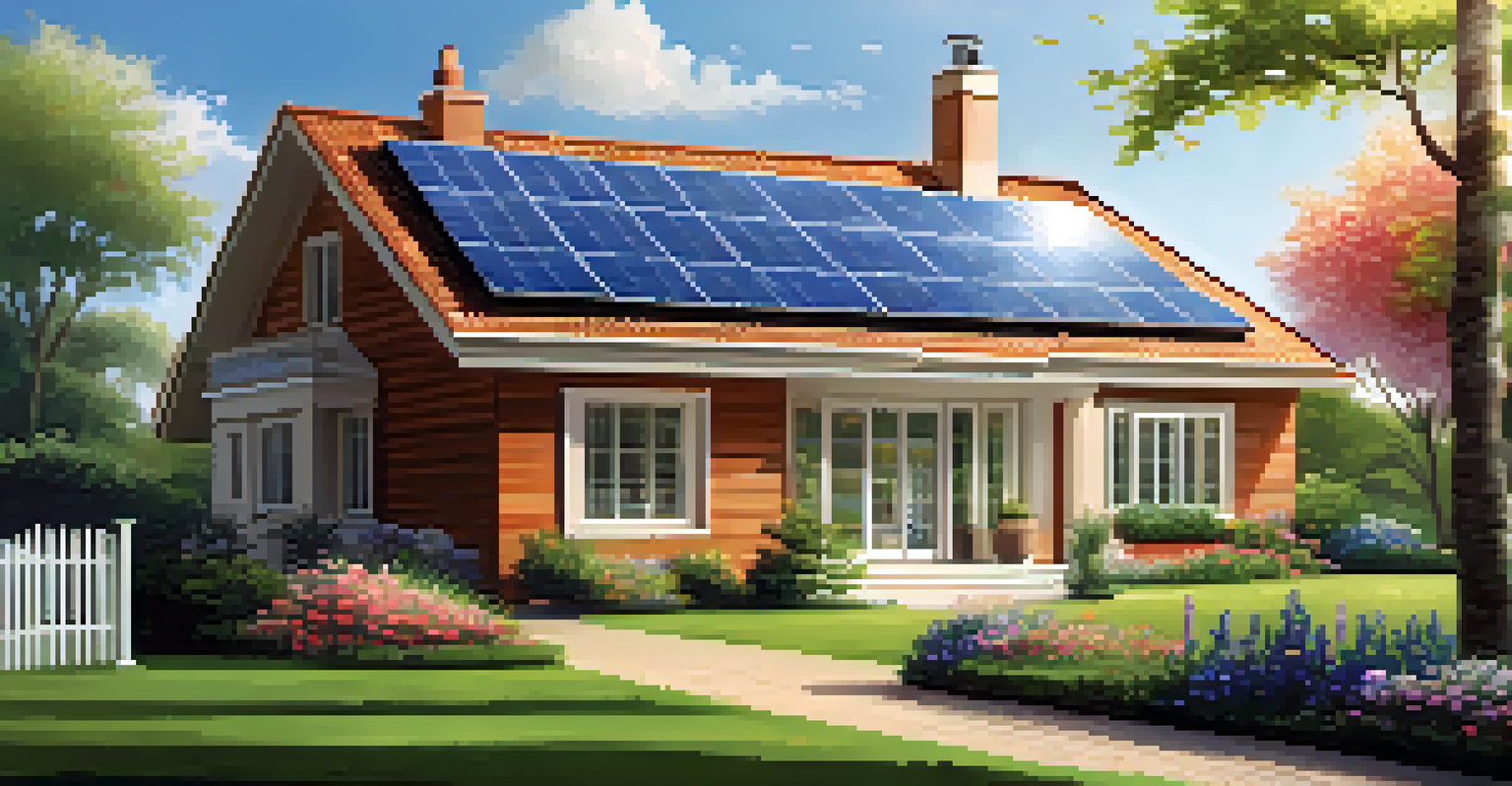Smart Home Energy Management Systems Explained

What Are Smart Home Energy Management Systems?
Smart Home Energy Management Systems (SHEMS) are integrated technologies designed to monitor and control energy usage in residential settings. These systems utilize smart devices to collect data on energy consumption patterns, allowing homeowners to make informed decisions on energy use. Imagine having a virtual assistant that not only manages your home but also helps you save on energy bills.
The best way to predict the future is to create it.
Through the use of sensors, smart meters, and connected appliances, SHEMS provide real-time insights into energy consumption. This means you can track usage trends and identify areas where energy is wasted. For example, if your system detects that your heating is running when no one is home, it can automatically adjust the temperature to save energy.
Ultimately, SHEMS empower homeowners to take control of their energy consumption, leading to both cost savings and a reduced environmental footprint. By optimizing energy use, these systems contribute to a more sustainable future, making them an attractive option for eco-conscious consumers.
Key Components of Smart Home Energy Management Systems
At the heart of any Smart Home Energy Management System are its key components, which include smart thermostats, smart plugs, and energy monitoring devices. Smart thermostats, like the Nest or Ecobee, adjust your home’s heating and cooling based on your habits, ensuring comfort while saving energy. Meanwhile, smart plugs allow you to control devices remotely, giving you the ability to turn off appliances that may be consuming energy unnecessarily.

Energy monitoring devices play a crucial role by providing detailed insights into your energy usage. They can alert you to irregularities, such as spikes in consumption, which could indicate a malfunctioning appliance. Imagine receiving a notification on your phone that your refrigerator is using more energy than usual—this kind of proactive management can save you money and extend appliance life.
SHEMS Optimize Energy Use
Smart Home Energy Management Systems help homeowners track and control their energy consumption, leading to cost savings and improved efficiency.
Together, these components create a comprehensive system that not only tracks but also optimizes energy use throughout the home. With this technology, managing your energy consumption is as easy as checking your smartphone, turning energy efficiency into a seamless part of your daily routine.
How SHEMS Improve Energy Efficiency
One of the standout benefits of Smart Home Energy Management Systems is their ability to improve energy efficiency. By providing real-time data on how and when energy is used, homeowners can pinpoint wasteful practices and make necessary adjustments. For instance, if you notice that certain appliances are consuming more energy during peak hours, you can schedule them to operate during off-peak hours when rates are lower.
Energy conservation is the foundation of energy independence.
Furthermore, SHEMS can integrate with renewable energy sources, such as solar panels, to maximize their efficiency. If your system detects that your solar panels are generating excess energy, it can adjust your home’s energy consumption to use that energy, reducing reliance on the grid. This not only saves money but also supports the use of cleaner energy.
In essence, SHEMS transform the way energy is consumed in homes, turning passive users into active energy managers. With the right systems in place, you can create a more energy-efficient home that aligns with both your budget and environmental goals.
Cost Savings with Smart Home Energy Management
Cost savings are often the primary motivation for homeowners considering Smart Home Energy Management Systems. By providing insights into energy consumption and enabling better control over devices, these systems can significantly reduce monthly utility bills. For example, simply adjusting your thermostat by a few degrees can lead to noticeable savings over time.
In addition to direct savings on energy bills, many utility companies offer incentives for homeowners who implement energy-efficient technologies. These can include rebates for purchasing smart devices or reduced rates for using energy during off-peak hours. It’s like getting paid to save energy—who wouldn’t want that?
Cost Savings with SHEMS
Implementing SHEMS can significantly reduce monthly utility bills, making them a financially savvy investment for homeowners.
Overall, the initial investment in a SHEMS can be recouped through these savings, making it not just a smart choice for the environment, but also a savvy financial decision. By investing in technology that promotes efficiency, you position yourself to benefit financially while also contributing to a sustainable future.
Enhancing Comfort and Convenience with SHEMS
Beyond energy savings, Smart Home Energy Management Systems significantly enhance the comfort and convenience of modern living. Imagine coming home to a perfectly heated or cooled house, all thanks to your smart thermostat adjusting based on your preferences and schedule. This level of automation means you can enjoy a comfortable environment without constantly fiddling with controls.
Moreover, the ability to monitor and control your home’s energy use from anywhere—via smartphone apps—adds a layer of convenience that many homeowners cherish. You can check the status of your appliances, adjust settings, or even turn devices on or off while at work or on vacation. It’s like having the power to control your home from the palm of your hand.
This combination of comfort and convenience makes SHEMS an attractive option for busy families and individuals alike. By automating energy management, these systems free up time and mental energy, allowing you to focus on what truly matters.
Environmental Impact of Smart Home Energy Management
Smart Home Energy Management Systems play a pivotal role in reducing the environmental impact of energy consumption. By optimizing energy use, these systems help lower greenhouse gas emissions, which are a major contributor to climate change. Imagine if every household adopted these technologies— the collective reduction in energy demand could lead to significant environmental benefits.
Additionally, SHEMS often encourage the use of renewable energy sources, like solar power, which further diminishes reliance on fossil fuels. By integrating with solar panels, these systems can ensure that homes use clean energy first, making it easier to reduce carbon footprints. It’s a small step for individual households but a giant leap for the planet.
Environmental Benefits of SHEMS
By promoting energy efficiency and the use of renewable sources, SHEMS contribute to reducing greenhouse gas emissions and supporting a sustainable future.
In essence, investing in SHEMS is not just a personal financial decision; it’s also a commitment to sustainability. By embracing these technologies, homeowners can contribute to a healthier planet for future generations.
Future Trends in Smart Home Energy Management Systems
The future of Smart Home Energy Management Systems looks promising, with advancements in technology continually enhancing their capabilities. One trend to watch is the integration of artificial intelligence (AI) into SHEMS. AI can analyze energy consumption patterns more effectively, allowing the system to make smarter adjustments based on user behavior and preferences, further optimizing efficiency.
Another exciting trend is the increasing interoperability between different smart home devices. As standards improve, homeowners will be able to create a more cohesive smart home ecosystem where devices communicate seamlessly. This means that your smart thermostat, lights, and appliances can work together to maximize energy savings and comfort.

As technology evolves, we can also expect more user-friendly interfaces that simplify the management of energy consumption. The goal is to make energy management so intuitive that everyone, regardless of tech-savviness, can easily benefit from these systems. The future of SHEMS promises a more connected, efficient, and sustainable living environment.